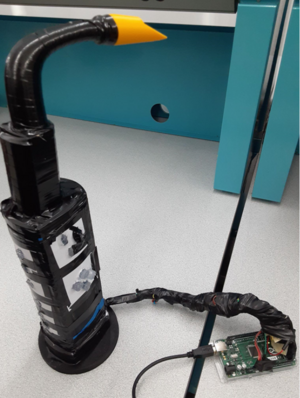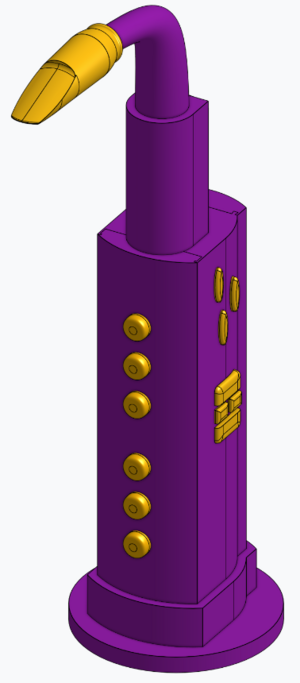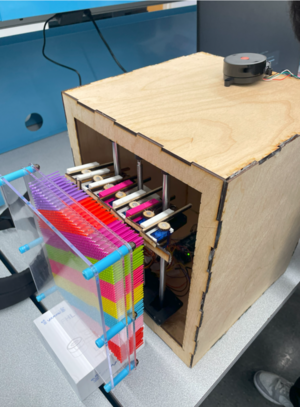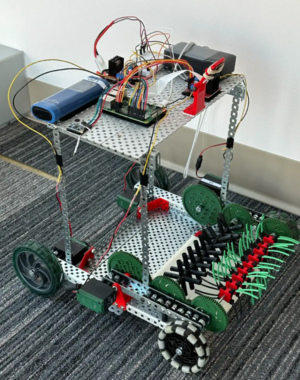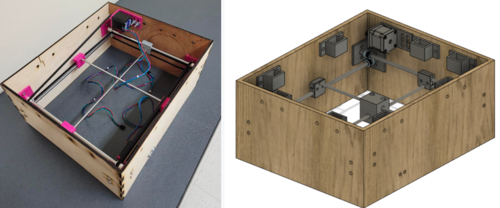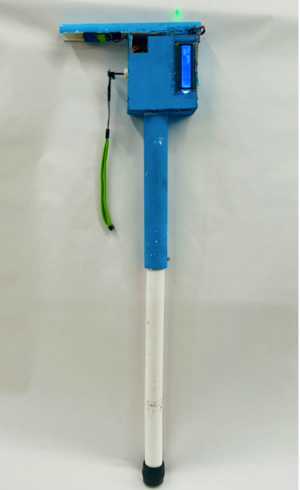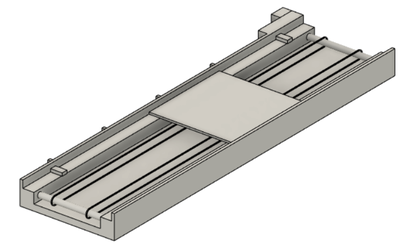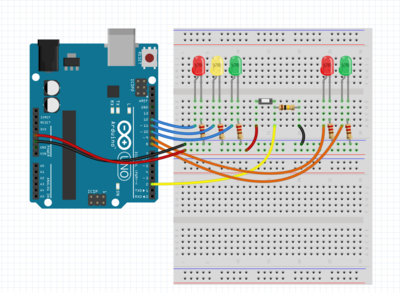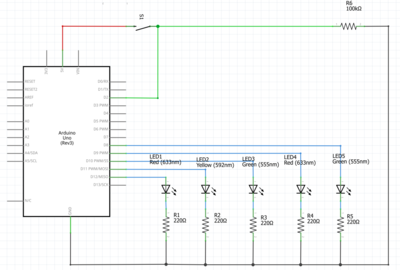Difference between revisions of "Rapid Assembly and Design Challenge (RAD)"
| Line 28: | Line 28: | ||
'''Audience:''' The Virtual Saxophone is targeted towards both new learned and experienced saxophone players. New players will benefit from the lower cost and ease of use, while experienced players will appreciate the convenience and additional customization options. | '''Audience:''' The Virtual Saxophone is targeted towards both new learned and experienced saxophone players. New players will benefit from the lower cost and ease of use, while experienced players will appreciate the convenience and additional customization options. | ||
Figure 1: Virtual Saxophone | [[File:Virtual_saxophone.png|300px|thumb|center|Figure 1: Final Virtual Saxophone Prototype]] | ||
[[File:Saxophone_cad.png|300px|thumb|center|Figure 2: Virtual Saxophone Final CAD Model]] | |||
== Topoviewer (Fall 2023) == | == Topoviewer (Fall 2023) == | ||
| Line 42: | Line 44: | ||
'''Audience:''' The primary target audience includes visually impaired individuals who can benefit from tactile navigation aids. Additionally, the device is useful for professionals in architecture and construction who rely on physical models for better visualization and interaction with prototypes. | '''Audience:''' The primary target audience includes visually impaired individuals who can benefit from tactile navigation aids. Additionally, the device is useful for professionals in architecture and construction who rely on physical models for better visualization and interaction with prototypes. | ||
Figure | [[File:Topoviewer.png|300px|thumb|center|Figure 3: Topoviewer]] | ||
== Robocaddy (Spring 2024) == | == Robocaddy (Spring 2024) == | ||
| Line 56: | Line 58: | ||
'''Audience:''' This project is targeted towards golfers, particularly those who seek a safer, more cost-effective, and eco-friendly alternative to traditional golf carts, as well as golf course owners looking to reduce labor costs. | '''Audience:''' This project is targeted towards golfers, particularly those who seek a safer, more cost-effective, and eco-friendly alternative to traditional golf carts, as well as golf course owners looking to reduce labor costs. | ||
Figure | [[File:Robocaddy.png|300px|thumb|center|Figure 4: Robocaddy]] | ||
== RoboChess and ChessBot (Fall 2022) == | == RoboChess and ChessBot (Fall 2022) == | ||
| Line 72: | Line 74: | ||
'''Audience:''' This project targets players with limited mobility, the elderly, and those who prefer to limit their screen time. It benefits anyone seeking a more accessible and convenient way to play chess, whether in tournament settings or casual play. | '''Audience:''' This project targets players with limited mobility, the elderly, and those who prefer to limit their screen time. It benefits anyone seeking a more accessible and convenient way to play chess, whether in tournament settings or casual play. | ||
Figure | [[File:Chessbot.png|500px|thumb|center|Figure 5: ChessBot]] | ||
[[File:Robochess.png|500px|thumb|center|Figure 6: RoboChess]] | |||
== Telescope Cane (Fall 2023) == | == Telescope Cane (Fall 2023) == | ||
| Line 86: | Line 89: | ||
'''Audience:''' The primary target audience includes individuals with physical disabilities who require mobility aids. FlexiCane is designed to help these individuals navigate their daily activities more independently and confidently, providing both safety and health monitoring features that are beneficial for their well-being. | '''Audience:''' The primary target audience includes individuals with physical disabilities who require mobility aids. FlexiCane is designed to help these individuals navigate their daily activities more independently and confidently, providing both safety and health monitoring features that are beneficial for their well-being. | ||
Figure | [[File:Telescope_cane.png|300px|thumb|center|Figure 7: Telescope Cane]] | ||
== Drawings == | == Drawings == | ||
Revision as of 20:35, 11 September 2024
Request for Proposal: Rapid Assembly and Design Challenge (RAD)
Introduction and Overview
The National Academy of Engineers (NAE) and the NYU Tandon School of Engineering are seeking proposals for prototypes that address any of the fourteen NAE Grand Challenges, which fall into four cross-cutting themes of Sustainability, Health, Security, and the Joy of Living.
Specifications
Those responding to this challenge are tasked with creating a physical prototype and sales pitch for their device. The prototype can be a new technology or an improvement to an existing technology.
Each project will have a purchasing allowance of $100.00 to be spent on components for the prototype. A TA mentor will be provided to help define the project scope, set tasks, and manage purchasing requests.
Each project must complete two benchmark assessments, A and B. Three milestone presentations will be made over the course of the semester. They should demonstrate steady progress over the 10 week duration of the project showing component testing and later prototype testing. The prototype must complete commissioning. Final submission and a final presentation will complete the project. Prototypes will be judged by professors at the end of the semester, and the best projects will be awarded a prize.
Project Ideas
Access this Google document for more information on project ideas and the following examples of past projects.
Virtual Saxophone (Fall 2022)
Group Members: James Arsenault, Bree Choi, Swaarthi Ramanan
Objective: The main goal of the Virtual Saxophone project is to create an affordable and convenient electronic saxophone that plays music like a real acoustic saxophone while significantly lowering the cost and weight barriers.
Features: Key features include the ability to mimic the sound of an acoustic saxophone, a lightweight and compact design, and the capability for customization to emulate various instruments and sounds. The design incorporates 19 pushbuttons, an airflow sensor, a resistometer, and an Arduino Mega to facilitate these functionalities.
Innovation: This project stands out due to its cost-effectiveness, being under $100 compared to the traditional $1,000 - $10,000 price range of acoustic saxophones. Additionally, its programmable nature allows for a level of sounds customization that traditional saxophones cannot offer, making it versatile for different musical styles.
Audience: The Virtual Saxophone is targeted towards both new learned and experienced saxophone players. New players will benefit from the lower cost and ease of use, while experienced players will appreciate the convenience and additional customization options.
Topoviewer (Fall 2023)
Group Members: Edward Kang, Jonathan Shan
Objective: The primary goal of this project is to develop a device that scans an area and creates a 3D physical layout of that area, providing a novel for various applications, particularly for the visually impaired.
Features: Key features include a rail-system and linear actuators for the mechanical creation of 3D models, lidar technology for scanning the area, and sophisticated software to process the data and control the device. These components work together to produce accurate and tactile 3D representations of scanned environments.
Innovation: This device is unique due to its combination of mechanical design and advanced scanning technology to create physical 3D models. The integration of lidar technology and custom-built rail systems and actuators distinguishes it as a novel and versatile tool for both accessibility and broader applications like architecture and construction.
Audience: The primary target audience includes visually impaired individuals who can benefit from tactile navigation aids. Additionally, the device is useful for professionals in architecture and construction who rely on physical models for better visualization and interaction with prototypes.
Robocaddy (Spring 2024)
Group Members: Alex Huang, Jason Tung, Jack Li, Samarth Pusegaonkar
Objective: The main goal of the Robocaddy project is to revolutionize the golfing experience by improving accessibility, sustainability, and player convenience through automated technology.
Features: Key features include custom 3D-printed components, VEX 393 motors for enhanced power, a Raspberry Pi 3 Model B+ for processing, and a Raspberry Pi Camera Module 3 with a 120" field of view for dynamic pathfinding.
Innovation: Robocaddy is unique due to its AI-powered dynamic pathfinding, which allows it to autonomously navigate golf courses, unlike other motorized or preprogrammed alternatives currently available.
Audience: This project is targeted towards golfers, particularly those who seek a safer, more cost-effective, and eco-friendly alternative to traditional golf carts, as well as golf course owners looking to reduce labor costs.
RoboChess and ChessBot (Fall 2022)
Group Members (ChessBot): Gerardo Eleguézbal, Natalie Baigorria, Chris Brasil, Yue (Kerry) Huang
Group Members (RoboChess): Alexander Escobar, Veikko Kurki, Summer Oh, Nathan Rampersaud
Objective: The main goal of ChessBot and RoboChess is to promote inclusivity and accessibility in chess by enabling users to control a chessboard using voice commands.
Features: Key features include voice-recognition technology for hands-free control, a robotic system to maneuver chess pieces based on voice inputs, and a physical board that provides a traditional playing experience. This design aims to enhance the gaming experience for users with limited mobility, the elderly, and those who prefer physical boards over digital apps.
Innovation: ChessBot and RoboChess are unique due to its integration of voice-controlled gameplay, a feature not available in current commercially available robotic chess board. This innovation bridges the gap in accessibility, making chess more inclusive for all players.
Audience: This project targets players with limited mobility, the elderly, and those who prefer to limit their screen time. It benefits anyone seeking a more accessible and convenient way to play chess, whether in tournament settings or casual play.
Telescope Cane (Fall 2023)
Group Members: Tyra Hirooka, Julia Alvarez, Sarah Bao
Objective: The primary goal is to empower individuals with physical disabilities by developing a cutting-edge, user-friendly telescopic cane that enhances navigation, safety, and health monitoring.
Features: Telescope Cane includes a telescopic design for easy portability and adjustable length, emergency sensors, such as a force sensor and pulse for monitoring, and safety features including an LED light for visibility and an LCD screen showing the user's BPM (heart rate). Additionally, it provides real-time heart rate data to give users valuable biofeedback.
Innovation: This project is unique due to its combination of mechanical and electrical components that not only aid in mobility but also ensure user safety and health monitoring. The integration of emergency sensors and biofeedback features distinguishes it as a multifunctional tool designed to significantly improve the quality of life for its users.
Audience: The primary target audience includes individuals with physical disabilities who require mobility aids. FlexiCane is designed to help these individuals navigate their daily activities more independently and confidently, providing both safety and health monitoring features that are beneficial for their well-being.
Drawings
Prototype designs must be rendered in computer aided design (CAD) software for Milestone presentations and Benchmarks A and B (Figure 7). Fusion 360 is the recommended software for this course, which may be downloaded for free using an NYU email address. Other CAD software, such as SolidWorks, Inventor, and Rhino are permitted, but EG1004 does not provide resources in obtaining or learning those programs. All designs must show four views of the device: front, top, most detailed side, and isometric. Sensors and motors must be included in each drawing.
Each revision of the design must be documented and all changes must be presented during Milestone presentations.
Diagrams
The circuit that powers and operates a prototype must be presented as a circuit diagram and a schematic diagram for milestones and benchmarks. A circuit diagram is a representation of the circuit, showing the physical layout of the wires and how the components are organized (Figure 8).
A schematic diagram shows the plans and functions of the circuit, but not the physical layout of the wires (Figure 9).
EG1004 recommends the circuitry modeling software Tinkercad and Fritzing to fulfill these deliverables. Tinkercad is a free browser-based circuitry software that is especially useful for constructing circuit diagrams with common electrical components. For projects with more complex electrical components, Fritzing is a free circuitry software with a library of electrical components that is useful for constructing circuit diagrams and schematic diagrams. For a guide on using both software, please refer to the Virtual Circuit Simulation Guide.
Remember to visibly label all components. In cases where the software does not support a specific component used within your design, use software like PowerPoint to amend your schematic.
Project Schedule
A project schedule must be created in Google Sheets. Please refer to the template provided in your team Google Drive folder and our guide.
This schedule must include all tasks related to the project from the start of the project to Early or Final submission. The project schedule should include:
- Minimum of 20 tasks, excluding Milestones
- Milestones should be clearly indicated on the project plan (duration of zero days)
- Each task must include the person responsible for completing the task (resource names)
- Gantt chart must be displayed alongside the tasks list (fit onto one slide)
- Gantt chart must show a progress line
- Clearly state during the presentations whether the project is on-time, behind schedule, or ahead of schedule
- In milestone presentations, please present a “Project Status” slide, which should summarize key deadlines. You are not required to show your project schedule in these presentations
Cost Estimate
A cost estimate must be generated that specifies the cost of all the materials and labor required for the design and construction of the prototype. The cost estimate must be presented in an Excel spreadsheet. Help in calculating the cost is available by reviewing How to plan the schedule and calculate costs for a project. Parts must be purchased from Amazon for ease of purchasing and faster delivery. Any adjustments or changes to the cost estimate over the semester must be documented and shown to the mentor.
The cost estimate should include the following:
- Labor cost breakdown with hours and rates. Labor is paid at $50/hr
- Cost of all materials and components
- Total cost must be shown in the bottom right corner
There should be no decimal places in the cost estimate as this is purely an estimate. Be sure to round appropriately.
Purchasing
The budget for this 10-week project is $100.00. Materials are available in Open Lab, the MakerSpace, or upon request. All materials must be approved by an EG TA (such as the mentor, Open Lab TA, or Protolab TA). The list of materials available for all RAD projects is available here.
VEX materials are also available for use. The list of VEX materials and their associated costs is available here.
Purchases can only be made for items on Amazon. Submit requests to purchase items through the Purchasing Form. After submitting the Purchasing Form, purchases must be approved by the mentor. The Purchasing Form can be found below. All items in this list are prohibited and cannot be purchased.
Make sure items are Prime eligible for faster delivery and the item must ship in less than seven days. Think ahead and order on time. Purchasing deadlines can be found on the section schedules and are as follows:
- September 30
- October 7
- October 15
- October 21
- October 28
For groups that require additional funding, the RAD Innovation Grant opens October 28 and is due by November 4. Groups can apply for more parts or for purchases that exceed their $100 budget and must justify their purchase. There is no guarantee that such a purchase request will be approved, and so it is suggested that all necessary purchases be made as soon as possible.
Weekly Meetings
Team members must schedule and attend weekly meetings with the RAD mentor. A time slot for this meeting must be selected collectively and once set, that time slot must be unchanged for the remainder of the semester. The RAD mentor will set the benchmarks, extra credit tasks, and assist in research and technical tasks. For additional technical help, go to Open Lab and an Open Lab TA will provide assistance. RAD mentors will present information regarding the project, deadlines, and benchmarks. The presentations can be found below:
CATME
When working on the project, peer evaluations and self-evaluations are critical for assessing how effective individual contributions are to the project. In the course, the recitation professor will use evaluations at each milestone using a software called the Comprehensive Assessment of Team Member Effectiveness (CATME). More information can be found on the Teamwork Expectations page.
Engineering Notebook
While working on this project, a record of all work done and all future plans and goals must be maintained in the Engineering Notebook. To complete benchmarks A or B, the Engineering Notebook must be shown to the Open Lab TA who is completing the assessment. For Milestone 1, Milestone 2, Milestone 3, and Final Submission, the Engineering Notebook must be approved by the Recitation Professor and be prepared to make it available to an Open Lab TA in a Word Document (DOC or DOCX) format. A guide to writing the notebook, an overview of the expectations, and how often the notebook should be updated can be found on the Keeping an Engineering Notebook page.
Extra Credit
RAD projects have multiple options for receiving extra credit.
- Extra credit tasks are determined by the mentor or professor based on the specific RAD project. The mentor will assign at least two tasks, with more if they want. Each task is worth 3 points, and a total of 6 points can be earned through extra credit regardless how many tasks are completed. If your group does not commission, then you will not receive any extra credit you would have otherwise received. Some examples may include:
- Website integrated with product
- App integration that provides additional functionality
- Wireframe app design
- Informational website
- Soldering
- Completing Early Submission. Refer to the EG1004 Grading Policy for exact point values.
Milestones, Benchmarks, and Deliverables
As work on the project proceeds, three Milestone presentations will be made during recitation. All the items assigned in each Milestone are called Benchmark deliverables. These deliverables often consist of a combination of written submissions, presentations, and demonstrations. Additionally, certain benchmarks assigned by the mentor must be met, and reports/deliverables that add to the progress and comprehensiveness of the project must be submitted. The 3D Printing and Logo Guide page contains information on the 3D printing requirements and guidelines.
Preliminary Design Investigation
The Preliminary Design Investigation (PDI) is extremely important, as it lays the groundwork for the project. The PDI outlines the project idea, inspiration, and goals.
The PDI must include:
- Cover Page
- Project Overview
- Goals & Objectives
- Design & Approach
- Cost Estimate
- Project Schedule
- Relevant Pictures
An example PDI template can be found here. The PDI must be reviewed and approved by the mentor by email by Benchmark A. Do not forget to include the items listed above, but do not feel limited to only these items. Use this link to access the PDI Rubric.
Milestone 1
Milestone 1 is a presentation of your Preliminary Design Investigation Report. It is important that you outline your project goals and show that your project is realizable. Your Milestone 1 presentation must include:
- Company profile
- Company name
- Product name
- Group member title(s)
- Mission statement
- Project Objective
- What is your project about?
- What tasks are you aiming to accomplish? (Benchmark A requirements)
- Overall design approach to complete objective
- Background Information
- Why is the project happening?
- What does the audience need to know?
- Technical design description
- Preliminary conceptual drawing of design
- Rendered and digital sketches are acceptable, CAD not required
- What components will be used and why?
- Preliminary conceptual drawing of design
- Cost estimate
- Major components of design listed
- Miscellaneous category listed
- Projected labor listed
- Microsoft Project schedule
- Click here to access the guide on how to transfer a file
- Teamwork agreement summary
- Summary
- Overall assessment on current state of project
- Are you on schedule? Are you on budget?
- Next steps and future tasks
See How to Give a Milestone Presentation for the format of a Milestone presentation. Because the project will differ in format from other SLDPs, please treat this How-To as a general guideline but not an exact template. Your personalized Benchmark A requirements will be given to you by your mentor, and you have some creative freedom with the format of your presentation.
Benchmark Assessment A
Benchmarks evaluate the progress of the project. Benchmark Assessment A is due at the end of Model Shop Session II. There are penalties for not completing this on time. Refer to the EG1004 Grading Policy for more information.
For the Benchmarks, the mentor will outline specific goals that the project must achieve to satisfy the Benchmark. These goals will vary depending on the project and mentor and will be determined based on the particular project's level of difficulty. Please be sure to submit the Benchmark deliverables via the EG1004 website.
To pass, the design must complete all of the following:
- Tasks assigned by the mentor
- Initial CAD model
- Preliminary Design Investigation
- Submit an .STL and a .3mf of the company logo through the 3D Printing Submission portal on the EG website
- The 3D Printing and Logo Guide contains information on the 3D printing requirements and guidelines.
- The Protolab schedule is available on the 3D Printing and Logo Guide
- Updated Engineering Notebook, which includes the PDI
Milestone 2
See How to Give a Milestone Presentation for the format of a Milestone presentation, but remember that individual formats will differ slightly. The specifications for the presentation are stated below.
Milestone 2 is a project progress update. Explain all changes and developments made to date, particularly in regards to Benchmark A. Include whether or not Benchmark A requirements were completed, and if not, explain why. Also, highlight any planned changes to the design or project, in general.
The Milestone 2 presentation must include:
- Company profile
- Company name
- Product name
- Group member title(s)
- Mission statement
- Project objective
- What is your project about?
- What tasks are you aiming to accomplish? (Benchmark A/Benchmark B requirements)
- Overall design approach to complete objective
- Background information
- Why is the project happening?
- What does the audience need to know?
- Technical design description
- Explanation of design changes, if any
- CAD drawings: top, front, most detailed side, and isometric view
- Circuit and schematic diagram(s)
- Relevant pictures
- Flowchart of code
- Cost estimate (previous and current costs)
- Major components of design listed
- Miscellaneous category listed
- Projected labor listed
- What changes were made, if any?
- Microsoft Project schedule (previous and current)
- What changes were made, if any?
- Click here to access the guide on how to transfer a file
- Summary
- Overall assessment on current state of project
- Are you on schedule? Are you on budget?
- Next steps and future tasks
Benchmark Assessment B
Benchmark Assessment B is due at the end of Model Shop Session III. There are penalties for not completing this on time. Refer to the EG1004 Grading Policy for more information.
Similar to Benchmark A, Benchmark B requirements will be determined and outlined by the mentor. Please submit the Benchmark deliverables via the EG1004 website.
To pass, the design must complete all of the following:
- Tasks assigned by the mentor
- Updated CAD Model
- Have an .STL and a .3mf of the company logo approved by a ProtoLab TA through the 3D Printing Submission portal on the EG website. Students must consult with a TA in the Protolab before their Modelshop Session 3 to get their logo approved. Logos cannot be approved during Modelshop sessions.
- The 3D Printing and Logo Guide contains information on the 3D printing requirements and guidelines
- The Protolab schedule is available on the 3D Printing and Logo Guide
- Updated Engineering Notebook
Milestone 3
See How to Give a Milestone Presentation for the format of a Milestone presentation, but remember that individual formats will differ slightly.
Milestone 3 will be the last project progress update. Explain all changes and developments made to date, particularly in regards to Benchmark B. Include whether or not Benchmark B requirements were completed, and if not, explain why. Also, highlight any planned changes to the design or project, in general.
The Milestone 3 presentation must include:
- Company profile
- Company name
- Product name
- Group member title(s)
- Mission statement
- Project Objective
- What is your project about?
- What tasks are you aiming to accomplish? (Benchmark A/Benchmark B/Commissioning requirements)
- Overall design approach to complete objective
- Background Information
- Why is the project happening?
- What does the audience need to know?
- Technical design description
- Explanation of design changes, if any
- CAD drawings: top, front, most detailed side, and isometric view
- Circuit and schematic diagram(s)
- Relevant pictures
- Flowchart of code
- Cost estimate (previous and current costs)
- Major components of design listed
- Miscellaneous category listed
- Projected labor listed
- What changes were made, if any?
- Microsoft Project schedule (previous and current).
- What changes were made?
- Click here to access the guide on how to transfer a file
- Summary
- Overall assessment on current state of project
- Are you on schedule? Are you on budget?
- Next steps and future tasks
Commissioning
. Refer to the syllabus for the Commissioning deadline. There are penalties for not completing this on time. Refer to the EG1004 Grading Policy for more information.
To Commission, the following must be completed:
- Fully-functional prototype
- Finalized CAD model
- Any additional deliverables designated to you by your mentor
- Have an .STL file of the company logo printed through the 3D Printing Submission portal on the EG website
- The 3D Printing and Logo Guide contains information on the 3D printing requirements and guidelines.
- The Protolab schedule is available on the 3D Printing and Logo Guide
- Updated Engineering Notebook
Final Design Report
The Final Design Report (FDR) provides a comprehensive overview of the project process and developments from initial brainstorm to finished prototype. All project expectations and outcomes must be clearly detailed in the document. This report will also provide the documentation experience that will be useful for completing a Senior Design final report and other projects. All FDRs must follow the EG style guide.
The FDR must include the following documentation:
- CAD drawings
- Wiring diagrams
- Project schedule
- Cost estimate
Use this Final Design Report template with the following outline:
- Introduction
- Purpose of Project
- Background
- Requirements
- Physical Components
- Software Components
- Procedures
- Physical Construction
- Software Setup
- Software Troubleshooting
- Milestone and Final Product Requirements
- Benchmark A Requirements
- Benchmark B Requirements
- Final Submission Requirements
- Human Resources and Training (e.g. TA expertise utilized, etc.)
- Results
- Benchmark A Results
- Benchmark B Results
- Difficulties Experienced
- Conclusion
- Results of Project
- Future Improvements
- Works Cited
The FDR is due with Final Submission.
Final Presentation
Final presentations for RAD projects are not like the Milestone presentations. Final presentations are a business pitch to showcase the work, the prototype, and the company. This pitch is a five minute presentation to show the achievements of the presenters, the company, and pitching the prototype to theoretical investors. Focus on topics such as the project application, a target audience for this product, why it is different from other products on the market, and the product's market value. Focus on keeping the audience engaged and interested in the product throughout the presentation. Feel free to be creative with the Final Presentation. The following must be addressed in the Final Presentation:
Your Final Presentation must include:
- Company Profile
- Company name
- Employee profile, role(s), and qualifications
- Mission statement
- Problem statement
- Why is the project happening?
- What does the audience need to know?
- Product objective
- What is the purpose of your product?
- Who does your product help?
- What problem does your project solve?
- Product description
- CAD drawings: top, front, most detailed side, isometric
- Circuit diagram(s)
- Flowchart of code
- Market and product viability
- Does your company have competitors?
- What makes your product unique?
- How does your design compare to competitors - cost, quality, features?
- Is the product versatile?
- Who will buy your product?
- What is the price of your product?
- Conclusion
- Reiterating product purpose
- Highlight product features
- Future goals of the company
- Video advertisement
- Price of product
- Demonstration of product
- Embedded into Final Presentation
Some examples of RAD Final Presentations can be seen below. A video advertisement must be included in the presentation.
Submission
All SLDP projects must be submitted online. Please visit https://eg.poly.edu/finalSLDP.php for the link to the Project Submission form and each project’s individualized login information. To submit, login to the EG1004 website using this special login information. Submitting with an NYU account or any other account will generate an error. Components may be resubmitted at any time before the deadline. Please note that submission times are based on the most recent submission.
Please note the deliverables for this project are as follows. If any of the following items are omitted, there will be a penalty. Be sure to click submit at the bottom of the form.
The following list are general items that are expected from all RAD groups:
- Final presentation
- Circuit Diagram
- Schematic Diagram
- Code Flowchart
- Commented code
- All CAD drawings of the design (initial through final)
- Video advertisement of the prototype in use
- Final Microsoft Project schedule
- Final cost estimate
- Resume(s) (no fictitious resumes will be accepted)
- Final Engineering Notebook
- Final Design Report
